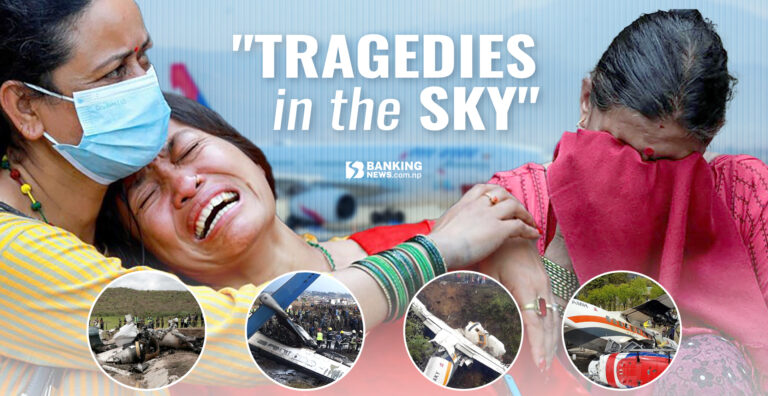Nepal’s aviation sector has long been plagued by a combination of political instability and challenging environmental conditions, resulting in a troubling history of plane crashes. The recent disaster in Kathmandu, which claimed 19 lives and left only one survivor, has once again brought Nepal’s aviation safety concerns to the forefront.
Unstable Political Landscape and Aviation Safety Concerns Nepal’s political volatility, coupled with its difficult flying conditions, has created a perilous environment for air travel. Frequent changes in government like a weather, combined with inadequate infrastructure and safety measures, have hindered the establishment of a robust aviation system. Additionally, the country’s economic challenges, including high unemployment rates and mass emigration, have further strained its aviation capabilities, leading to safety lapses.
The Kathmandu Plane Crash In a tragic incident, a Saurya Airlines plane crashed shortly after takeoff from Kathmandu, resulting in the loss of 19 lives. The aircraft, which turned into a fireball upon impact, left only the pilot alive. This devastating event has once again highlighted the critical need for enhanced aviation safety protocols in Nepal.
Operating Challenges in Nepal’s Airspace Nepal’s air safety record is marred by the difficult operating conditions its pilots face. The country’s uneven terrain, coupled with unpredictable weather patterns, poses significant challenges for even the most experienced aviators. Kathmandu’s airport, situated in a valley surrounded by mountains, presents additional visibility and navigation difficulties, further elevating the risks for both pilots and passengers.
The Urgent Need for Safety Reforms With more than 50 plane crashes in the past three decades, the urgency for aviation safety reforms in Nepal cannot be overstated. The government and the civil aviation authority have come under increasing scrutiny for shortcomings in pilot training and aircraft maintenance. It is imperative that Nepal addresses these gaps and implements comprehensive safety measures to protect its aviation workforce and passengers.
Preventing airline crashes in Nepal, where challenging terrain and weather conditions pose significant risks, requires a multifaceted approach that includes improving infrastructure, technology, training, and regulatory oversight. Here are several strategies that could help:
1. Enhanced Pilot Training
- Mountain Flying Skills: Pilots flying in Nepal should receive specialized training in mountain flying, focusing on handling difficult approaches and managing unpredictable weather conditions.
- Simulator Training: Regular simulator training for handling emergency scenarios specific to Nepal’s challenging environments can better prepare pilots.
2. Improved Weather Forecasting
- Advanced Meteorological Systems: Invest in state-of-the-art weather forecasting technology to provide real-time, accurate weather data to pilots and air traffic controllers.
- Local Weather Stations: Establish more localized weather stations in remote areas to monitor conditions closely.
3. Upgraded Air Traffic Control (ATC) Systems
- Radar Coverage: Enhance radar coverage, especially in remote and mountainous regions, to improve aircraft tracking and communication.
- Communication Infrastructure: Invest in better communication infrastructure between ATC and aircraft to ensure constant contact, even in remote areas.
4. Aircraft Technology Upgrades
- Terrain Awareness and Warning Systems (TAWS): Equip all aircraft with TAWS, which alerts pilots to potential terrain collisions.
- Satellite Navigation Systems: Utilize satellite-based navigation systems like GPS to provide more accurate routing and positioning information.
5. Airport Infrastructure Improvements
- Runway Upgrades: Improve runway infrastructure, especially at remote airports, to handle adverse weather conditions and larger aircraft.
- Advanced Landing Systems: Install Instrument Landing Systems (ILS) and other advanced landing aids at airports to assist in low-visibility conditions.
6. Stricter Regulatory Oversight
- Safety Audits: Conduct regular safety audits of airlines and enforce strict compliance with international aviation safety standards.
- Incident Reporting: Encourage transparent reporting of incidents and near-misses to analyze trends and improve safety measures.
7. Emergency Preparedness and Response
- Rescue Operations Training: Ensure that local emergency services and rescue teams are well-trained and equipped to respond quickly to aviation incidents.
- Crisis Management Plans: Develop comprehensive crisis management plans for airports and airlines to handle emergencies efficiently.
8. International Collaboration
- Partnerships with Global Experts: Collaborate with international aviation safety organizations to share best practices and implement global safety standards.
- Technical Assistance: Seek technical assistance and funding from international bodies to upgrade infrastructure and training programs.
By implementing these strategies, Nepal can enhance the safety of its aviation sector, reducing the risk of accidents in its challenging flying environment.
The tragic plane crash in Kathmandu underscores the pressing need for immediate action to improve aviation safety in Nepal. To prevent further loss of life, it is crucial for the country to confront the challenges within its aviation sector and take decisive steps toward ensuring safer skies for all.



 About Us
About Us
Comment